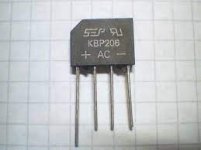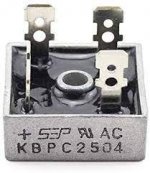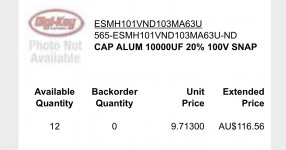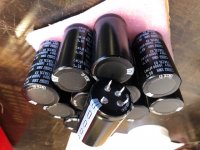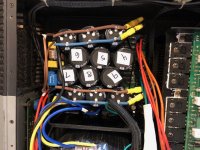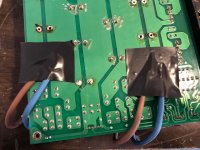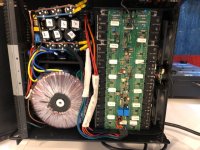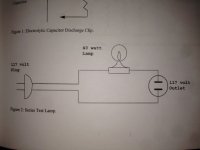WRONG.I opened a cap. It’s dry like the desert. The rattle was the tightly rolled wad of paper loose in the canister.
I ordered 12 replacements. I got 100v ones as anything else is prohibitively expensive.
Under that "logic", fill your car tank with water, gas is so expensive!!!!! 🙄
The upper ones need *at least* a 120V rating, they cost what they cost.
Drying them up is the least problem you may have, it´s very possible (given constant creeping up Mains Voltages) that they "pee" all around or plain burst.
I think the OP has no real intentions to effectively repair the amp, but rather to experiment a bit, rummaging through the drawer of disused materials.
Which is not objectionable at all, but ... has it ever happened to you that you used faulty components again for not having thrown them away at the time?
Which is not objectionable at all, but ... has it ever happened to you that you used faulty components again for not having thrown them away at the time?
Hi friends,
I checked the bridge rectifiers and the three of them measure correctly in terms of passing current in the right direction.
Yes, should have upspecced the components, but since this is what it came with new a decade ago, would I be naive to expect at least ten years light use out of it?
Appreciate the patrol / water example. Analogous to that would be using a resistor instead of a capacitor 😉
I checked the bridge rectifiers and the three of them measure correctly in terms of passing current in the right direction.
Yes, should have upspecced the components, but since this is what it came with new a decade ago, would I be naive to expect at least ten years light use out of it?
Appreciate the patrol / water example. Analogous to that would be using a resistor instead of a capacitor 😉
When nominal voltage and temperature specs are kept the same, component quality plays a serious part in longevity expectation also. A Nippon Chemi-Con is not a Thicon for instance. What exact brand and model you ordered? What is its maxed out operation lifetime spec?
I got the cheapest part from digikey. AU$10/pop and they had them in stock. ESMH101VND103MA63U
565-ESMH101VND103MA63U-ND
CAP ALUM 10000UF 20% 100V SNAP
565-ESMH101VND103MA63U-ND
CAP ALUM 10000UF 20% 100V SNAP
philschl;6672235 ............. I checked the bridge rectifiers and the three ...........[/QUOTE said:😕
I see four "packages" , but if you have controlled the two bridges associated with the higher caps, it will be enough.
Are they individual diodes or are they packs of four bridged ?
Attachments
Last edited:
Seriously....this is a barely able piece, you will need to check out the entire unit.
Invest in a DMM with capacitance function.
Chinese capacitors, to put it mildly, tend to be wildly off spec, so do most of the other parts.
If you got it even for free, think how much in parts, time and planning will go in fixing this, and how reliable it will be.
My advice is to do it only if you really like the sound.
Invest in a DMM with capacitance function.
Chinese capacitors, to put it mildly, tend to be wildly off spec, so do most of the other parts.
If you got it even for free, think how much in parts, time and planning will go in fixing this, and how reliable it will be.
My advice is to do it only if you really like the sound.
** I'm slow 😱 -- this is responding to post 44 **
No, that would NOT be naïve, providing that ..
- you subject it to EXACTLY the same power conditions day after day and night
- the replacement parts are EXACTLY the same specification and quality, including temperature rating, ESR, overload tolerance, and probably others I'm not smart enough to quote
- you operate it EXACTLY as it was run originally, for each of those 3½ thousand days
It's also unlikely that the original capacitors woke up one morning and spilled their guts all at the same time -- at least a few of them failed several hundred operating hours ago, and there's no predicting which ones would, and which ones survived longer. It just isn't a logical, linear relationship.
Cheers
edit: Wow, your Digi-Key price is sure better than mine -- $18,27 USD ea @quantity 10! Is your dollar that much stronger these days?!
No, that would NOT be naïve, providing that ..
- you subject it to EXACTLY the same power conditions day after day and night
- the replacement parts are EXACTLY the same specification and quality, including temperature rating, ESR, overload tolerance, and probably others I'm not smart enough to quote
- you operate it EXACTLY as it was run originally, for each of those 3½ thousand days
It's also unlikely that the original capacitors woke up one morning and spilled their guts all at the same time -- at least a few of them failed several hundred operating hours ago, and there's no predicting which ones would, and which ones survived longer. It just isn't a logical, linear relationship.
Cheers
edit: Wow, your Digi-Key price is sure better than mine -- $18,27 USD ea @quantity 10! Is your dollar that much stronger these days?!
Last edited:
I got the cheapest part from digikey. AU$10/pop and they had them in stock. ESMH101VND103MA63U
565-ESMH101VND103MA63U-ND
CAP ALUM 10000UF 20% 100V SNAP
A most reliable brand. Its their proven SMH line, the 100V DC has 125V surge spec. Its the four pin version code though. Two extra pins for stability.
"Use the blank terminals for mechanical support only. The blank terminals must not be connected to a solder trace on the PC board, but be electrically isolated from the negative or positive terminal."
😕
I see four "packages" , but if you have controlled the two bridges associated with the higher caps, it will be enough.
Are they individual diodes or are they packs of four bridged ?
Two four-pin rectifiers for the HV+ / HV- and one for LV+ / LV-
** I'm slow 😱 -- this is responding to post 44 **
No, that would NOT be naïve, providing that ..
edit: Wow, your Digi-Key price is sure better than mine -- $18,27 USD ea @quantity 10! Is your dollar that much stronger these days?!
Audusd=.78 so yours is quite a bit stronger. Probably other factors at work. Who knows where the pricing comes from. There must be stupid margins on the parts to warrant stock management across millions of SKUs.
There seems also to be a long waiting period for many items like 30+ weeks in many cases. First time shopping for caps so may be normal or it may be yet another Covid supply chain issue?
Attachments
Two four-pin rectifiers for the HV+ / HV- and one for LV+ / LV-
Well, the remaining rectifier which section of the amplifier feeds?
It would be interesting a photograph of the front of the amplifier and another porn (without clothes) .......🙂
The new caps arrived today. Order date was 27/May. Today is 31/May. They came from USA to Melbourne, Australia. And postage was not charged extra. And we are in lockdown. And these were the cheapest caps that fit the specification. And they were well packed.
Let's just say Digikey will continue to have my business!
Fly in the ointment is that I didn't check the specifications carefully enough and the pin spacing doesn't fit the board. My mistake. So I had to rig up external rails, as you can see. I used some spare wire that runs the 30 amp pool chlorinator, so should be OK.
To troubleshoot the problem I simply replaced the stuffed caps with the new ones. And bingo! The 'clip' LED is now off.
Some pictures as requested.
I might just replace the "still OK" caps as well and drill holes to fit the new caps on the board proper, but for now I'm chuffed that the fix seems to have done the trick.
Let's just say Digikey will continue to have my business!
Fly in the ointment is that I didn't check the specifications carefully enough and the pin spacing doesn't fit the board. My mistake. So I had to rig up external rails, as you can see. I used some spare wire that runs the 30 amp pool chlorinator, so should be OK.
To troubleshoot the problem I simply replaced the stuffed caps with the new ones. And bingo! The 'clip' LED is now off.
Some pictures as requested.
I might just replace the "still OK" caps as well and drill holes to fit the new caps on the board proper, but for now I'm chuffed that the fix seems to have done the trick.
Attachments
Good news then! 🙂 Before definitely testing it with the speakers, connect it to the AC line through a serial lamp.
This will prevent further damage to the amplifier (main out TR, those are expensive) if any issues still persist.
This will prevent further damage to the amplifier (main out TR, those are expensive) if any issues still persist.
This is the basic diagram, you have to put lamps (one or more in series) that are less than the power (Watts) of general consumption of the amplifier, look at the back of the equipment, where the power cable penetrates. As soon as you turn on the amplifier, the lamps turn ON BRIEFLY AND THEN STAY OFF IF ALL IS OK.
Attachments
Thanks for the tip. I have a sacrificial speaker I picked up for $1 that I hooked up and it’s all working. Most amazing, apart from very minor fan noise it’s totally silent with no humming or hissing as is often heard through PA amps. Signal plays nicely when applied. Pots have no dirt in them. This amp is a keeper!
The series lamp protects the amplifier, the "sacrificial" loudspeaker does not, but if everything worked well, congratulations on the job!
Please check the condition of the capacitors on the lower voltage rails also, they might have been affected.
Congratulations, now spray the pots and switches.
I was going to tell you to try and exchange the capacitors for higher voltage types...
Anyway it seems you got good quality ones, so they will hopefully last longer than the Chinese junk ones.
Later, you can think of moving these to the lower voltage rails, and getting new high voltage ones for use on the high voltage rails, and wiring them directly, as I suggested.
Congratulations, now spray the pots and switches.
I was going to tell you to try and exchange the capacitors for higher voltage types...
Anyway it seems you got good quality ones, so they will hopefully last longer than the Chinese junk ones.
Later, you can think of moving these to the lower voltage rails, and getting new high voltage ones for use on the high voltage rails, and wiring them directly, as I suggested.
Perhaps to wrap up, I thoroughly cleaned all parts and replaced the old fans as they had developed a rattle with a couple noktua units I had lying around from a past PC build. No the amp is near silent.
I remeasured dc volts and got 162.7, 71, -71.3, -163.2. This looks ok to me. I also measured dc offset and got ch a: 0.035; ch b: 0.005, bridged 0.027. That’s with nothing connected and gain to minimum.
I’ve not yet had a chance to put the amp in its designated spot and connect peripherals but I think there won’t be any surprises. Oh, resting idle power consumption measured at the GPO is 40w. On power up the wattmeter goes up to 500w very briefly though.
No bump through the speakers when turning on to off.
I’m happy with the result and thank you all for the ideas and stimulating discussion.
I remeasured dc volts and got 162.7, 71, -71.3, -163.2. This looks ok to me. I also measured dc offset and got ch a: 0.035; ch b: 0.005, bridged 0.027. That’s with nothing connected and gain to minimum.
I’ve not yet had a chance to put the amp in its designated spot and connect peripherals but I think there won’t be any surprises. Oh, resting idle power consumption measured at the GPO is 40w. On power up the wattmeter goes up to 500w very briefly though.
No bump through the speakers when turning on to off.
I’m happy with the result and thank you all for the ideas and stimulating discussion.
- Home
- Amplifiers
- Power Supplies
- Inconsistent voltage after rectifier
